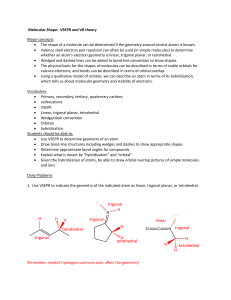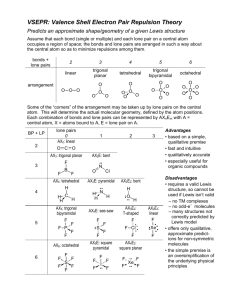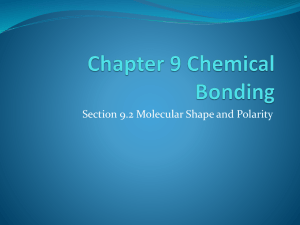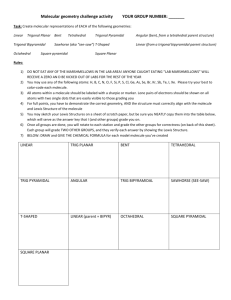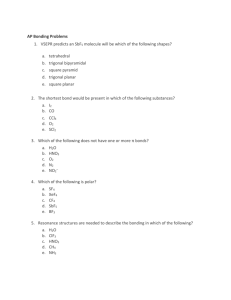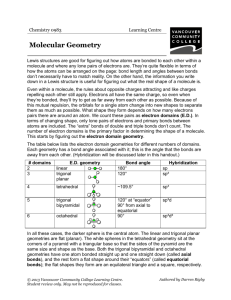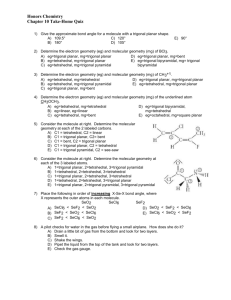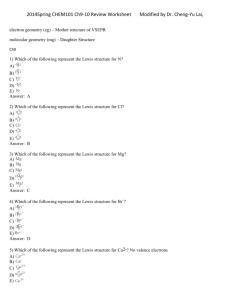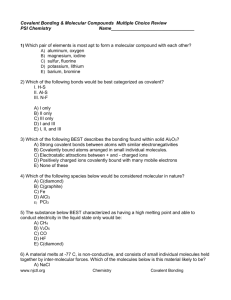exam-3b - Prince George`s Community College
advertisement
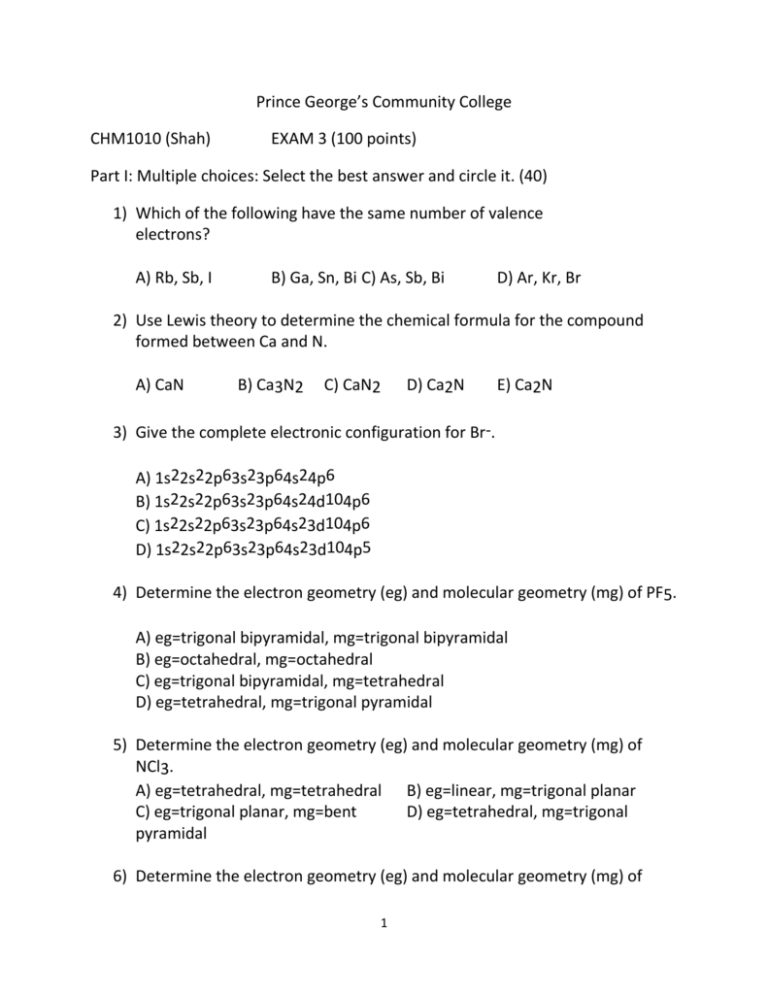
Prince George’s Community College CHM1010 (Shah) EXAM 3 (100 points) Part I: Multiple choices: Select the best answer and circle it. (40) 1) Which of the following have the same number of valence electrons? A) Rb, Sb, I B) Ga, Sn, Bi C) As, Sb, Bi D) Ar, Kr, Br 2) Use Lewis theory to determine the chemical formula for the compound formed between Ca and N. A) CaN B) Ca3N2 C) CaN2 D) Ca2N E) Ca2N 3) Give the complete electronic configuration for Br-. A) 1s22s22p63s23p64s24p6 B) 1s22s22p63s23p64s24d104p6 C) 1s22s22p63s23p64s23d104p6 D) 1s22s22p63s23p64s23d104p5 4) Determine the electron geometry (eg) and molecular geometry (mg) of PF5. A) eg=trigonal bipyramidal, mg=trigonal bipyramidal B) eg=octahedral, mg=octahedral C) eg=trigonal bipyramidal, mg=tetrahedral D) eg=tetrahedral, mg=trigonal pyramidal 5) Determine the electron geometry (eg) and molecular geometry (mg) of NCl3. A) eg=tetrahedral, mg=tetrahedral B) eg=linear, mg=trigonal planar C) eg=trigonal planar, mg=bent D) eg=tetrahedral, mg=trigonal pyramidal 6) Determine the electron geometry (eg) and molecular geometry (mg) of 1 XeF2. A) eg=trigonal bipyramidal, mg=bent B) eg=linear, mg=linear C) eg=tetrahedral, mg=linear D) eg=trigonal bipyramidal, mg=linear 7) Determine the electron geometry (eg) and molecular geometry (mg) of XeF4. A) eg=tetrahedral, mg=tetrahedral B) eg=tetrahedral, mg=bent C) eg=trigonal bipyramidal, mg=tetrahedral D) eg=octahedral, mg=square planar 8) A molecule containing a central atom with sp3d hybridization has a(n) electron geometry: A) tetrahedral C) trigonal planar B) octahedral D) trigonal bipyramidal 9) Draw the Lewis structure for OF2. What is the hybridization on the O atom? A) sp 10) B) sp3 D) sp3d E) sp3d2 Draw the Lewis structure for the molecule CH2CHCH3. How many sigma and pi bonds does it contain? A) 8 sigma, 1 pi 11) C) sp2 B) 9 sigma, 0 pi C) 9 sigma, 1 pi D) 7 sigma, 2 pi Which of the following statements is TRUE? A) An ionic bond is much stronger than most covalent bonds. B) An ionic bond is formed through the sharing of electrons. C) Ionic compounds at room temperature typically conduct electricity. D) Once dissolved in water, ionic compounds rarely conduct electricity. 2 E) None of the above is true. 12) Place the following elements in order of increasing electronegativity. K Cs P A) P < K < Cs 13) B) K < P < Cs C) Cs < P < K D) Cs < K < P Place the following in order of increasing radius. Ca2+ S2- Cl- A) Ca2+ < Cl< S2B) Cl- < Ca2+ < S2C) S2- < Cl- < Ca2+ D) Ca2+ < S2- < Cl14) Choose the compound below that contains at least one polar covalent bond, but molecule is nonpolar. A) HCN 15) B) CF4 C) SeBr4 D) ICl3 What is the molecular geometry of TeF4? A) seesaw B) square planar C) square pyramidal D) tetrahedral 16) Consider the molecule below. Determine the molecular geometry at each of the 2 labeled carbons. A) C1 = tetrahedral, C2 = linear 3 B) C1 = trigonal planar, C2= bent C) C1 = bent, C2 = trigonal planar D) C1 = trigonal planar, C2 = tetrahedral E) C1 = trigonal pyramidal, C2 = see-saw 17) Draw the Lewis structure for BrCl3. What is the hybridization on the Br atom? A) sp3d2 B) sp3d C) sp3 D) sp2 18) Choose the bond below that is most polar. A) H-I B) H-Br C) H-F D) H-Cl Part II Problems solving: (60 points) 1. Explain an appropriate chemical bond in each of the following compounds/molecules. (10) Na2S SbCl3 CS2 GaH3 4 2. Write EG, MG, bond angle, Polar or Nonpolar, hybridization, number of sigma bonds, and number of pi bonds around central atom in the following molecules or ions. (20 points) a. H2Se b. TiCl4 c. XeO4 d. CH3COOH 3. Draw the Lewis structures and calculate the formal charges for each atom. (10) a. C2H5Cl 5 b. PCl3 c. CO 4. Draw the possible Lewis structure and write all resonance structures. (10) a. CO32- b. HCO2- 6 5. True or False (10) a. The ability of an atom to attract electrons to itself in a chemical bond is called electronegativity. b. In metallic bond, electrons pooled between metal and nonmetal. c. In C2H4 molecule, there are 5 sigma bonds and only one pi bond. d. Average bond energy for double bond between carbon and carbon is higher than triple bond between carbon and carbon. e. Triple bonds are shorter than double bonds. 7
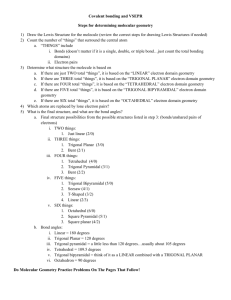
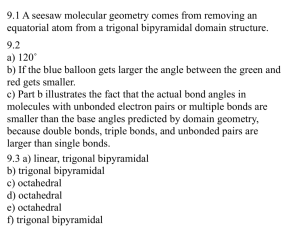
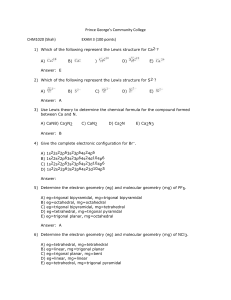
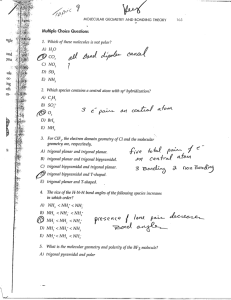
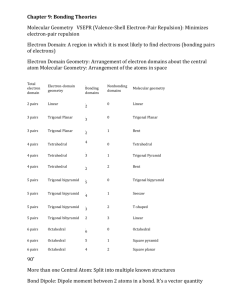
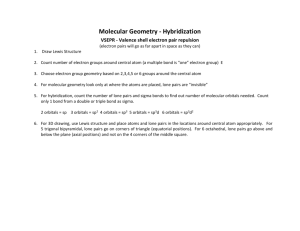
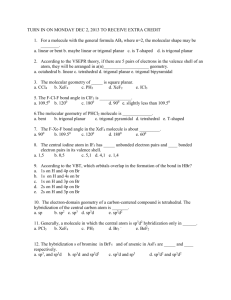
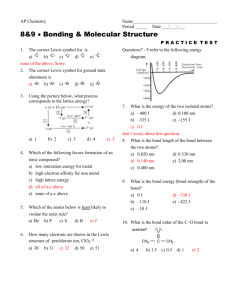
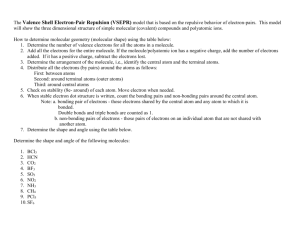
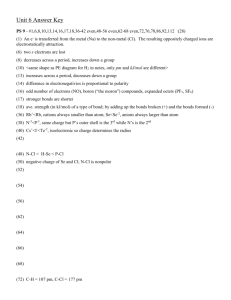
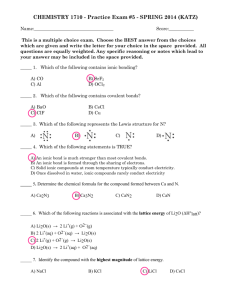
![VSEPR [Compatibility Mode]](http://s3.studylib.net/store/data/008210566_1-9238cc104b5d8abec6ce7a8d91d0b7ef-300x300.png)
